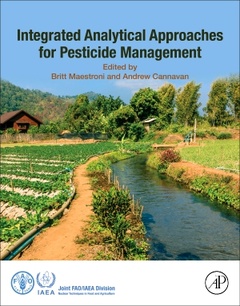Description
Integrated Analytical Approaches for Pesticide Management
Coordinators: Maestroni Britt, Cannavan Andrew
Language: English
Subjects for Integrated Analytical Approaches for Pesticide Management:
Keywords
14C-pesticides; 2; 4-D; Accuracy; Animals; Aquatic environment; BMWP; Bias; Biochar; Biodiversity; Bioindicators; Biological monitoring; Biomarkers; Biomonitoring indexes; Bioremediation; Black-box; Buffer zone; Catchment; Catchment scale; Chromatography; Clean-up; Contamination; Data interpretation; Degradation; Depth incremental sampling; Detection methodologies; Drift; Effects; Environmental distribution; Environmental fate; Environmental impact assessment; Erosion measures; Erosion mitigation strategies; Exposure; Extraction methods; Fertilizers; Folidol 600; Geophagus brasiliensis; Good agricultural practices; ISO 17025; Instrumental analysis; Integrated analytical approaches; Integrated approach; Integrated monitoring; Latin America; Lessons learned; Liquid/liquid extraction; Macroinvertebrates; Management; Mitigation; Model approaches; Model categories; Model evaluation; Model scale; Model selection; Monitoring; Oreochromis niloticus; Outcome; Passive sampler; Pesticide management practices; Pesticide residues; Pesticides; Phytoremediation; Plants; Population; Quality assurance; Radiation; Radiotracer techniques; Random; Recommendations; Risk assessment; Risk indicators; River sediment; River water quality; Runoff; Sample preparation; Sampling; Sampling aim; Sampling strategies; Soil contamination; Soil monitoring; Soil sampling devices; Soils; Solid-phase extraction; Sorption; Species diversity; Stratified; Sugarcane farming; Systematic; Transport processes; Vineyard management; Water; Wind drift
338 p. · 21.4x27.6 cm · Paperback
Description
/li>Contents
/li>Readership
/li>Biography
/li>Comment
/li>
Integrated Analytical Approaches for Pesticide Management provides proven laboratory practices/examples and methods necessary to control pesticides in food and water in various environments. The book presents insights into good laboratory practices and examples of methods used in individual specialist laboratories, thus enabling stakeholders in the agri-food industry to appreciate the importance of proven, reliable data and the associated quality assurance approaches for end product testing for toxic levels of contaminant residues in food. The book is written in a rigorous, but simple, way to make sure that a broad range of readers can appreciate its technical content.
The book's practical nature and generic guidelines distinguish it from others in the marketplace.
1. Introduction 2. Generic guidelines on integrated analytical approaches to assess indicators of pesticide management practices at a catchment scale. Black-box monitoring and the laboratory’s role in fostering good agricultural practice 3. Sampling strategies 4. Implementation and optimization of soil sampling: some practical guidance and considerations 5. Ecological Risk Assessment of Pesticides Used in Agriculture 6. Biodiversity and Biomonitoring Indexes 7. Use of biomarkers for studying the effects of pesticides on freshwater organisms 8. Overview of Analytical Methodologies and Techniques for Pesticide Residue Analysis 9. Pesticides in water, soil and sediments 10. Quality control measures at the analytical laboratory 11. The use of nuclear techniques for environmental studies 12. Easy to use pesticide fate/effects models and statistical tools 13. Environmental Risk Indicators: Their Potential Utility in Pesticide Risk Management and Communication 14. Remediation and Mitigation Strategies 15. Integrated Analytical Monitoring 16. Assessment of potential risks and effectiveness of agrochemical usage in a catchment: a case study of the Nzoia Nucleus Estate sugarcane farms in western Kenya 17. Indicators of Good Agricultural Practises in Viticulture 18. Conclusions and recommendations
Appendix 1. Description of the Pesticide Impact Rating Index (PIRI) 2. Framework for sampling for pesticides in water/sediments 3. Sampling tools and procedures 4. Linking soil and pesticide behaviour at a landscape scale: the way forward to opening the black-box 5. Biomonitoring validation 6. Interpreting water and soil monitoring parameters
Lab Managers and analysts, scientists/researchers, students and regulators in food control and agricultural contaminants
Laboratory Head, Food and Environmental Protection Laboratory, Joint FAO/IAEA Division of Nuclear Techniques in Food and Agriculture, Department of Nuclear Sciences and Applications
- Provides coverage of risk assessment and effective testing technologies
- Covers generic guidelines on pesticide analysis on different environmental matrices for use in the developed and developing world
- Presents the most up-to-date information in research sample testing preparation and method validation to detect pesticide residues in food
- Includes examples of each method for practical application
- Demonstrates proven, reliable research data and the associated quality assurance approaches for end product testing for food, water and soil sediment
- Describes the concept of integrated analytical approaches for pesticide management practices




